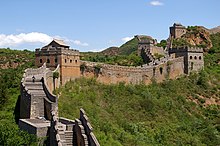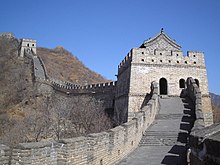Other purposes of the Great Wall have included border controls, allowing the imposition of duties on goods transported along the Silk Road, regulation or encouragement of trade and the control of immigration and emigration. Furthermore, the defensive characteristics of the Great Wall were enhanced by the construction of watch towers, troop barracks, garrison stations, signaling capabilities through the means of smoke or fire, and the fact that the path of the Great Wall also served as a transportation corridor.
The Great Wall stretches from Shanhaiguan in the east, to Lop Lake in the west, along an arc that roughly delineates the southern edge of Inner Mongolia. The most comprehensive archaeological survey, using advanced technologies, has concluded that all the walls measure 8,851.8 km (5,500.3 mi). This is made up of 6,259.6 km (3,889.5 mi) sections of actual wall, 359.7 km (223.5 mi) of trenches and 2,232.5 km (1,387.2 mi) of natural defensive barriers such as hills and rivers.

Characteristics
Before the use of bricks, the Great Wall was mainly built from rammed earth, stones, and wood. During the Ming Dynasty, however, bricks were heavily used in many areas of the wall, as were materials such as tiles, lime, and stone. The size and weight of the bricks made them easier to work with than earth and stone, so construction quickened. Additionally, bricks could bear more weight and endure better than rammed earth. Stone can hold under its own weight better than brick, but is more difficult to use. Consequently, stones cut in rectangular shapes were used for the foundation, inner and outer brims, and gateways of the wall. Battlements line the uppermost portion of the vast majority of the wall, with defensive gaps a little over 30 cm (12 in) tall, and about 23 cm (9.1 in) wide.Condition
While some portions north of Beijing and near tourist centers have been preserved and even extensively renovated, in many locations the Wall is in disrepair. Those parts might serve as a village playground or a source of stones to rebuild houses and roads. Sections of the Wall are also prone to graffiti and vandalism. Parts have been destroyed because the Wall is in the way of construction.More than 60 km (37 mi) of the wall in Gansu province may disappear in the next 20 years, due to erosion from sandstorms. In places, the height of the wall has been reduced from more than five meters (16.4 ft) to less than two meters. The square lookout towers that characterize the most famous images of the wall have disappeared completely. Many western sections of the wall are constructed from mud, rather than brick and stone, and thus are more susceptible to erosion.
Watchtowers and barracks
Communication between the army units along the length of the Great Wall, including the ability to call reinforcements and warn garrisons of enemy movements, was of high importance. Signal towers were built upon hill tops or other high points along the wall for their visibility.Visibility from space
Visibility from the moon
One of the earliest known references to this myth appears in a letter written in 1754 by the English antiquary William Stukeley. Stukeley wrote that, "This mighty wall of four score miles in length (Hadrian's Wall) is only exceeded by the Chinese Wall, which makes a considerable figure upon the terrestrial globe, and may be discerned at the moon." The claim was also mentioned by Henry Norman in 1895 where he states "besides its age it enjoys the reputation of being the only work of human hands on the globe visible from the moon." The issue of "canals" on Mars was prominent in the late 19th century and may have led to the belief that long, thin objects were visible from space. The claim that the Great Wall is visible also appears in 1932's Ripley's Believe it or Not strip and in Richard Halliburton's 1938 book Second Book of Marvels.The claim the Great Wall is visible has been debunked many times, but is still ingrained in popular culture. The wall is a maximum 9.1 m (30 ft) wide, and is about the same color as the soil surrounding it. Based on the optics of resolving power (distance versus the width of the iris: a few millimeters for the human eye, meters for large telescopes) only an object of reasonable contrast to its surroundings which is 70 mi (110 km) or more in diameter (1 arc-minute) would be visible to the unaided eye from the moon, whose average distance from Earth is 384,393 km (238,851 mi). The apparent width of the Great Wall from the moon is the same as that of a human hair viewed from 2 miles (3.2 km) away. To see the wall from the moon would require spatial resolution 17,000 times better than normal (20/20) vision. Unsurprisingly, no lunar astronaut has ever claimed to have seen the Great Wall from the moon.
Visibility from low earth orbit
A more controversial question is whether the Wall is visible from low earth orbit (an altitude of as little as 100 miles (160 km)). NASA claims that it is barely visible, and only under nearly perfect conditions; it is no more conspicuous than many other man-made objects. Other authors have argued that due to limitations of the optics of the eye and the spacing of photoreceptors on the retina, it is impossible to see the wall with the naked eye, even from low orbit, and would require visual acuity of 20/3 (7.7 times better than normal).Astronaut William Pogue thought he had seen it from Skylab but discovered he was actually looking at the Grand Canal of China near Beijing. He spotted the Great Wall with binoculars, but said that "it wasn't visible to the unaided eye." U.S. Senator Jake Garn claimed to be able to see the Great Wall with the naked eye from a space shuttle orbit in the early 1980s, but his claim has been disputed by several U.S. astronauts. Veteran U.S. astronaut Gene Cernan has stated: "At Earth orbit of 100 miles (160 km) to 200 miles (320 km) high, the Great Wall of China is, indeed, visible to the naked eye." Ed Lu, Expedition 7 Science Officer aboard the International Space Station, adds that, "it's less visible than a lot of other objects. And you have to know where to look."
In 2001, Neil Armstrong stated about the view from Apollo 11: "I do not believe that, at least with my eyes, there would be any man-made object that I could see. I have not yet found somebody who has told me they've seen the Wall of China from Earth orbit. ...I've asked various people, particularly Shuttle guys, that have been many orbits around China in the daytime, and the ones I've talked to didn't see it."
In October 2003, Chinese astronaut Yang Liwei stated that he had not been able to see the Great Wall of China. In response, the European Space Agency (ESA) issued a press release reporting that from an orbit between 160 and 320 km, the Great Wall is visible to the naked eye. In an attempt to further clarify things, the ESA published a picture of a part of the “Great Wall” photographed from Space. However, in a press release a week later (no longer available in the ESA’s website), they acknowledged that the "Great Wall" in the picture was actually a river.
Leroy Chiao, a Chinese-American astronaut, took a photograph from the International Space Station that shows the wall. It was so indistinct that the photographer was not certain he had actually captured it. Based on the photograph, the China Daily later reported that the Great Wall can be seen from space with the naked eye, under favorable viewing conditions, if one knows exactly where to look. However, the resolution of a camera can be much higher than the human visual system, and the optics much better, rendering photographic evidence irrelevant to the issue of whether it is visible to the naked eye.


No comments:
Post a Comment